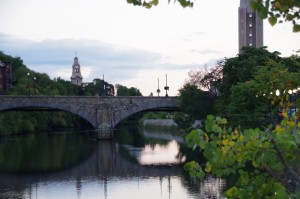
(Photo: Michael Bilow)
The City of Pawtucket pulled out all the stops to honor Morris Nathanson on September 8, the day before his 90th birthday, at the “Curtain Up” gala opening of the 2017 Pawtucket Arts Festival. The bridge carrying Exchange Street over the Blackstone River between Roosevelt Avenue and Broadway had previously been named for Nathanson, but at the REVEL Factory, the new home of “living art” performance group TEN31 Productions, with an excellent view of the bridge, its new lights were ceremonially switched on for the first time.
Known for decades-long advocacy on behalf of the arts and creative community, Nathanson is credited with aggressively promoting innovative zoning practices that encouraged converting unused factory and warehouse spaces into combined live-work spaces. In the 2008 documentary Pawtucket Rising, Nathanson recalled, “I went to the city council and convinced them to create special zoning for live/work, which did not exist in Rhode Island at the time. There were kids, artists who were living illegally in department stores and whatnot, but I wanted it part of zoning, a legal thing. They agreed with that. That was the beginning.” He said the first building he rehabilitated was in “the very worst condition,” but he chose it for its location: directly across the street from the high school he attended many years earlier, right off Interstate 95 and only a few minutes from the train station.
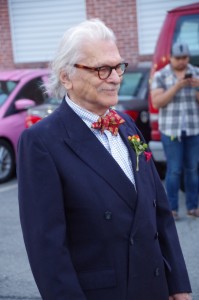
(Photo: Michael Bilow)
At his 90th birthday, Nathanson took advantage of the opportunity to exhort the crowd to consider design factors at the new Pawtucket Red Sox stadium being considered for the former Apex department store site. “I’m not 90 years old yet, that will be tomorrow… I think one of the problems we’ve been having with the community regarding the PawSox is that the issue has not been big enough: It’s been all about Pawtucket…. What I’m getting at is that, why could you not have art as a mix with sports, with baseball? Why couldn’t you do that? I’ve been in the stadium and there are long corridors with all sorts of plaques on it regarding all of the heroic things the PawSox have done over the years. Could you imagine artwork done by the artists in Rhode Island on those walls? Could you imagine how wonderful it would be if a family could take their children not just to see a baseball game, but to see art, art that is local, art that is real, that is successful? The schools do not do enough to promote art and you cannot promote art by teaching art: You have to promote art, whether it’s music, or ballet, or painting, by osmosis: exposing people, young people, to it. You cannot teach it, you cannot instruct it.”
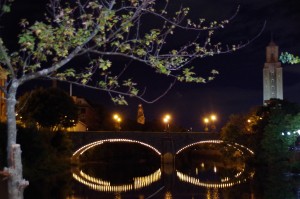
(Photo: Michael Bilow)
Nathanson also bluntly criticized one aspect of the design he had seen for the new PawSox stadium. “The second part of the idea is something that may be a catalyst for downtown, and that would be to create something that is very active, that invites people to come to Pawtucket, that reaches out to Millennials who will not only come to this great edifice for the art and the baseball, but also places to communicate. Millennials right now, as you know, love to engage in communication: They love the cafe spirit, not the large restaurants and whatnot… Now, as you know, the existing Apex building facing the river has a wall, a blank wall. You can go underneath the beautiful bridge on Taft Street and you see a blank wall. The plans I saw for the PawSox show another blank wall there facing the river. This is such a stupid idea. Why would you want a blank wall on the river where you can have small cafes and pubs and whatnot on the riverbank?”
“So please, remember now, at my age, ideas can still work,” Nathanson joked. “I cannot be that physically active, so you must get behind it.”
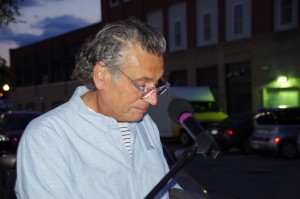
(Photo: Michael Bilow)
Antiques dealer and historian Richard Kazarian, who introduced Nathanson at the ceremony, later told Motif, “I think I expressed my sentiments this evening about how fortunate Pawtucket is to have someone of Morris’ ability and how fortunate I am as a friend to have such an inspirational figure. I grew up in Pawtucket, same neighborhood as Morris, and Morris is one of those rare men who came back home and devoted himself to the city’s improvement, and there’s not many cities that could count on someone of his abilities to help elevate our cause.
“I’ve known of Morris since childhood because our families were connected as friends, and I’ve actually bought his artwork over the years, but it wasn’t until I came home about a dozen years ago that our friendship really developed,” Kazarian said to Motif. “It’s a funny thing that Pawtucket people, to some extent, we counted on ourselves to help bring about Pawtucket’s revival. We had no wealthy patrons, we had no colleges or universities, we don’t have the Doris Duke of Newport or the Antoinette Downing of Providence, no cognoscenti, no illuminati, we’re kind of left to our own resources. Which is okay because when others see what we’re attempting to do, however admirable, they think we’re just trying to do too much, that Pawtucket will always have its limitations and even trying to introduce the arts to a classic mill town might be too much. We don’t feel that way at all, and where the experts always cautioned us to curb our enthusiasm, we knew we were capable of exceptional things, and having Morris on our side was always going to make us have that confidence that we would need. I couldn’t be prouder of him. The bridge is a small gesture but I think you can tell from tonight the kind of respect that he has.”
Herb Weiss, the economic and cultural affairs officer for Pawtucket, attended the bridge lighting ceremony and echoed what he said in the Pawtucket Rising documentary a decade ago, telling Motif, “Pawtucket was one of the first communities in Rhode Island where we have legal live-work space for artists. It all started with Morris about 30 years ago. He spearheaded an effort of artists and local creative type people to go to the city council to change the zoning…. He’s had his fingerprints over the last 30 years on every major arts initiative in the state and he’s always worked closely with city government to push the arts as an economic engine. Because of Morris, we’ve had hundreds of artists move into Pawtucket.”
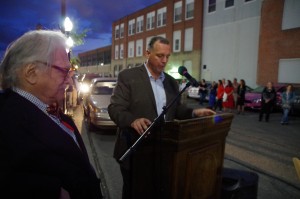
(Photo: Michael Bilow)
Pawtucket Mayor Donald Grebien told Motif, “It’s exciting when we bring a community together like this to see a lighting of a bridge… we’re dedicating it to Morris Nathanson who has lived his life here in Pawtucket, and I know he’s going to get mad at me for saying this, but we all talk about turning 90 and having that passion, so it’s a great community and people like Morris have made an opportunity for people like myself to lead this community in different directions and we appreciate that.” About Nathanson and his contribution to the city, Grebien said, “I’ve gotten to know Morris, I was on the council so I’ve known Morris in my political career about 20 years… and at times he’s passionate, at times he’ll drive you crazy because he’s so passionate, but if you stop and really look at what he started many years ago, buying the first mill building in downtown and renovating it into a studio and then being well known for that, and then I think he was a pioneer before he knew he was a pioneer, and what I like most about it is that, while he’s gotten a little older his passion for the city hasn’t changed.” Agreeing that Nathanson was instrumental in zoning for combined live-work space for artists, Grebien said, “It took that creative mind to tell us governmental folks… how important and what it was to mix the business with the creative, so it’s been very, very important.”
The PawSox stadium project faces obstacles but Grebien is optimistic, he said. “It’s really important to educate the people because people have this fear that we’re going to be raising taxes here in the city to pay for it; that’s not the case. The taxes are going to be generated from the new stadium, it would generate the revenue. So it’s trying to get people to understand that because you have the nay-sayers out there, and there’s a lot of skepticism because of 38Studios and because of other bad investments. This is nothing like that, so we’re excited about having people become understanding about the process.”
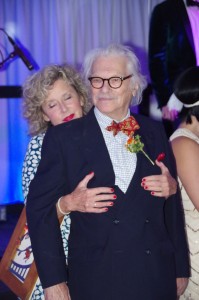
(Photo: Michael Bilow)
In an interview with Motif at the Curtain Up event after the bridge lighting, Nathanson said, “I’m overwhelmed. First of all, it was a surprise, a complete surprise. I’m overwhelmed, I’m almost embarrassed because of all the attention.” Asked what he was most proud of accomplishing in Pawtucket, he said, “Finding a way to save all the mills when they were being dismissed or torched or torn down, and coming back and being able to save the mills as places for artists to work and live in.”
As to the future of the city, he said, “It depends on a couple of very important things. The first would be, what happens with the PawSox. The second thing would be, how the area around the proposed train station would be developed; that’s a very important area.” Is the train station project a catalyst? “For the area where it is, yes, because there are many fabulous buildings there that should be saved and put into use primarily as a major arts community.” How would the train station area relate to the existing arts district? “It could be expanded to that area. Can you imagine how wonderful it would be, an artist community right next to a train station with direct communication between Pawtucket and Boston?” Is he optimistic the train station project will happen? “It will probably take quite a while, but yes, the people in Pawtucket and the administration have been very active.”
What was most instrumental in saving the historic mills? “By far, the zoning change: making it legal for artists to not only work but to live in the lofts. Imagine this: an artist graduates from RISD and with one rent they have a living space, a studio, and a place to have their own intimate gallery to sell their works. The proof is that it’s working.”
How much influence did the Pawtucket Rising documentary have? “It was a wonderful documentary, [director Jason Caminiti] did a great job… It had a major influence, and the other things that followed were very important, too, like The Gamm Theatre and then the art school.” Does he see more moving into the area, following the lead of Burbage Theater relocating into Pawtucket from Providence? “I think it’s going to depend on how active the Pawtucket administration gets involved. As long as the community can make it a welcoming area for artists, they will come here. Yes, they will, especially now that things are so expensive and unattainable in Boston, the arts community will also move here.”
What does he think of the current Pawtucket city administration? “I think the mayor [Grebien] is doing a very good job, and he’s being a very hard-working mayor, and I’m hoping that the mayor can reach out to the best kind of intelligence he can acquire, meaning resourceful people who have good experience and good leadership ability, and I think if he had a strong group to work with him, I think much can be accomplished. He, himself, is a good leader.”
If there was one thing he could do for Pawtucket, what would it be? “It would be to come up with the most creative, outstanding way of bringing the PawSox to the Apex building, even if Pawtucket has to sacrifice a bit of self-identity by suggesting that is a State of Rhode Island stadium and make it a larger entity than it might seem to be.”
In closing, Nathanson said, “Regarding tonight’s events, I’m so honored and pleased, much of it has been kept as a surprise to me, and I cannot say enough appreciation for the event.”
Video of lighting ceremony including Nathanson’s full speech (11m21s): dailymotion.com/video/x612mr6
Pawtucket Rising documentary, directed by Jason Caminiti: pawtucketrising.info Full video (53m41s): vimeo.com/21521280
Clarification: The term “architect” is here used figuratively to describe Nathanson’s role in the Pawtucket revival, not to represent that he is accredited or licensed as an architect.

